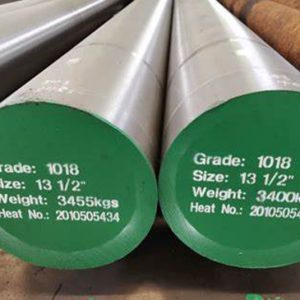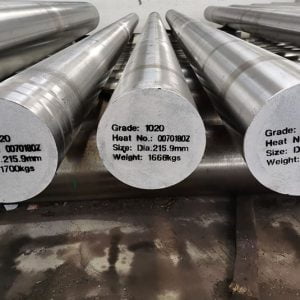Introduction

Selecting the right materials for your engineering or construction project is crucial for its success, and 1045 steel round bar is a popular choice due to its excellent balance of strength, toughness, and machinability. In this comprehensive guide, we will delve into the properties, applications, and key considerations for selecting the perfect 1045 steel round bar for your needs. This article will provide detailed insights and practical advice to ensure you make an informed decision.
Understanding 1045 Steel Round Bar
What is 1045 Steel?
1045 steel is a medium-carbon steel known for its good machinability, high strength, and excellent wear resistance. It typically contains 0.43%-0.50% carbon content, making it suitable for a wide range of applications where strength and toughness are required.
Properties of 1045 Steel Round Bar
1045 steel round bars exhibit a balance of properties that make them versatile for various industrial uses. Here are the key properties:
- Tensile Strength: Approximately 570-700 MPa
- Yield Strength: Around 300 MPa
- Brinell Hardness: 170-210 HB
- Elongation: 16-22%
- Modulus of Elasticity: 205 GPa
Applications of 1045 Steel Round Bar
1045 steel round bars are widely used in manufacturing and engineering applications. Common applications include:
- Shafts: Ideal for motor shafts, drive shafts, and pump shafts due to their strength and wear resistance.
- Machine Parts: Frequently used in the production of gears, bolts, and crankshafts.
- Construction: Utilized in structural components that require a high degree of strength and toughness.
- Automotive Industry: Applied in making parts like axles and steering components.
Key Considerations for Selecting 1045 Steel Round Bar
Choosing the right 1045 steel carbon round bar involves evaluating several factors to ensure it meets the specific requirements of your project.
Size and Dimensions
The dimensions of the steel round bar are crucial for its compatibility with your project. Common sizes range from 1/4 inch to several inches in diameter. Ensure the chosen diameter and length fit your application needs.
Mechanical Properties
Assess the mechanical properties such as tensile strength, yield strength, and hardness. These properties should align with the performance requirements of your application. For instance, high tensile strength is essential for load-bearing applications.
Heat Treatment
1045 steel can be heat treated to enhance its mechanical properties. Consider whether your application requires additional heat treatments such as quenching and tempering to achieve the desired hardness and strength.
Surface Finish
The surface finish of the steel round bar can affect its performance, especially in applications where friction or wear resistance is critical. Options include hot rolled, cold drawn, and precision ground finishes.
Cost
Cost is always a factor in material selection. 1045 steel is cost-effective for many applications, but it’s essential to balance cost with performance needs.1783 bronze, on the other hand, offers excellent wear resistance and corrosion resistance properties, making it a suitable choice for applications where durability is key. However, its higher cost compared to 1045 steel must be carefully considered in the decision-making process.
Table: Comparison of 1045 Steel Round Bar Sizes and Properties

| Diameter (inches) | Tensile Strength (MPa) | Yield Strength (MPa) | Hardness (HB) | Typical Applications |
|---|---|---|---|---|
| 1/4 | 570-700 | 300 | 170-210 | Small precision parts, pins |
| 1/2 | 570-700 | 300 | 170-210 | Shafts, mechanical parts |
| 1 | 570-700 | 300 | 170-210 | Larger machine components, gears |
| 2 | 570-700 | 300 | 170-210 | Heavy-duty construction, automotive |
| 3 | 570-700 | 300 | 170-210 | Structural supports, large equipment |
Conclusion
Selecting the right 1045 steel round bar for your project involves careful consideration of various factors, including size, mechanical properties, heat treatment, surface finish, and cost. Understanding the unique properties and applications of 1045 steel round bars will help you make an informed decision, ensuring the success of your engineering or construction project. Whether you’re working on automotive parts, structural components, or precision machinery, 1045 steel round bars offer the strength, toughness, and versatility needed to meet your demands.
FAQ
What are the main advantages of using 1045 carbon steel round bar?
1045 steel round bars offer a great combination of strength, toughness, and machinability. They are suitable for various industrial applications and can be heat treated for improved performance.
Can 1045 carbon steel round bar be welded?
Yes, 1045 steel round bar can be welded using appropriate techniques. However, preheating and post-weld heat treatment may be necessary to avoid cracking and ensure optimal weld quality.
What is the difference between hot rolled and cold drawn 1045 carbon steel round bar?
Hot rolled 1045 steel round bars are produced at high temperatures and typically have a rougher surface finish and looser tolerances. Cold drawn 1045 steel round bars are processed at room temperature, offering a smoother finish and tighter tolerances, which is ideal for precision applications.
How does heat treatment affect the properties of 1045 steel round bar?
Heat treatment, such as quenching and tempering, can significantly enhance the hardness, strength, and wear resistance of 1045 steel round bars. This process allows for customization of the material properties to meet specific application requirements.
Are there any specific storage requirements for 1045 steel round bars?
1045 steel round bars should be stored in a dry, clean environment to prevent rust and corrosion. Proper storage racks should be used to avoid bending or warping of the bars.





